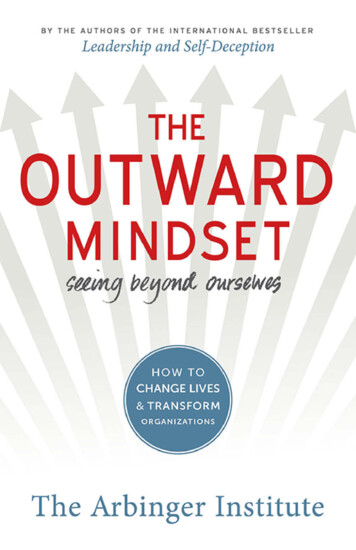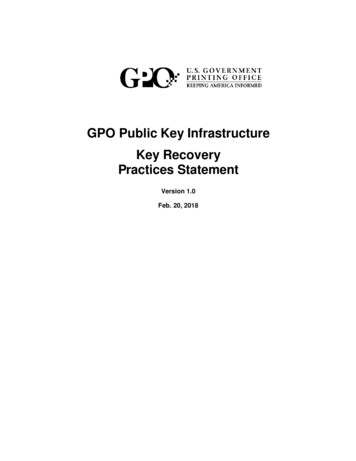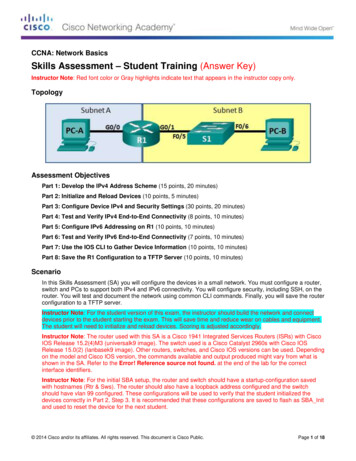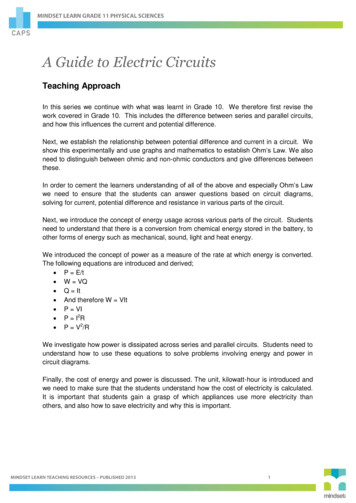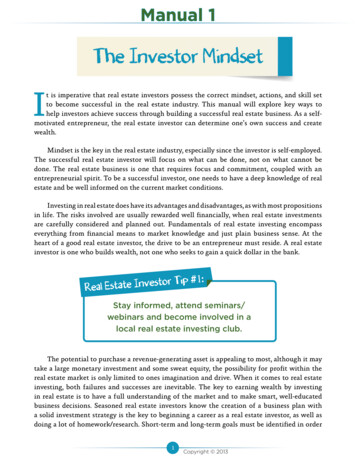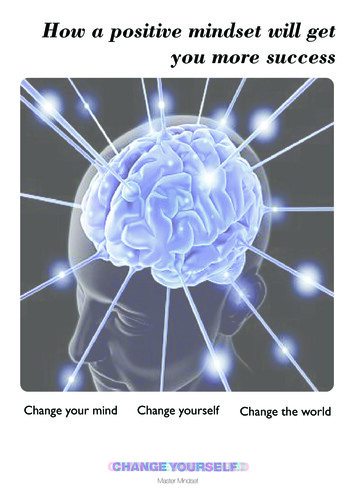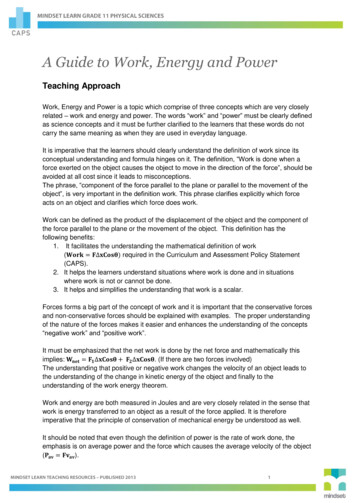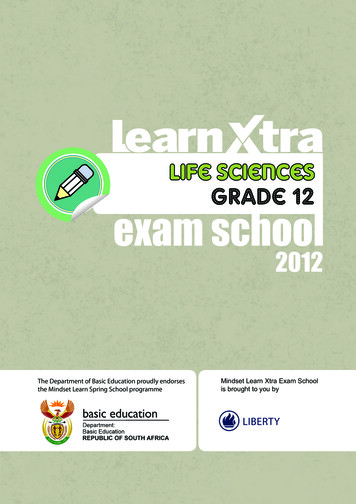
Transcription
Mindset: A Key toStudent MotivationPatrice PalmerTESL Hamilton ConferenceApril 2015
Today Mindsets- Fixed vs. Growth Mindsets How it applies to Language Learning andStudent Motivation The Role of Instructors Some hands-on activities Questions?
Disclaimer
MINDSETSELF-ASSESSMENTAdd up your points.You will get a scoresheet to take homeat the end of theworkshop.
The Problem experienceteaching in a post-graduateprogram - 4 cohorts lack of interest/unmotivated little improvement in skills, no effort realization that it wasn’t the smarteststudents who learned but the ones whopersevered despite failure andchallenges
“Good evening Teacher, Today in thecultural refection I got 50% .Respected , Teacher please tell memy mistakes so that i will not repeatthe same in next assignment . You arevery motivational teacher as you toldme my weak points in writing . Now, Iam doing good efforts for overcomethis. Thank you for this from my coreof my heart.”
Researching the ProblemReadings: motivation positive psychology (grit) neuroscience (growth mindset) education SLA (role of T in Ss motivation) growth mindset approach in 3rdcohort
End of Semester Reflection“Thank you for the book. It's been alwaysyour words, which motivates me to workhard. I will try to work hard and continue toput more effort to improve my writing skills”.“I am grateful. I will put my best efforts to getgood marks in future writings and will notdissappoint you. I hope to get support, helpand encouragement from you”.
End of Semester Reflection“Change in life is necessary and apositive change is always better. Inthe end, I want to say that “Effortsequals to Results”. I have a positiveattitude to learning. I love to gainnew experiences and knowledge(growth mindset)”.
End of Semester Reflection“I have a positive attitude to learning. I love togain new experiences and knowledge and agrowth mindset”.“I learnt through this that, although do manyattempts, but never give up as tiredness at thefinal end stage”.“The biggest thing I realized on each step isefforts result. I am thankful to you formotivating and encouraging me”.
GRIT leading grit researcher Angela Duckworth defines grit as“perseverance and passion for long-term goals.” students with high levels of grit are more successful in bothacademic and non-academic and non-academicpursuits research in the area of grit suggests that IQ is notnecessarily a predictor of academic success however grit is “the gritty individual approaches achievement as amarathon his or her advantage is stamina” and “staysthe course”As instructors, we know that language learning is like amarathon. It requires learners to persevere for a long time(Duckworth, Peterson, Matthews & Kelly, 2007)
HOW IS GRITDEVELOPED?Researchsuggests thatgrit can bedevelopedthrough agrowthmindset
Malleable Intelligence TheoryMalleable: means that you canshape or change somethingIntelligence: means yourability to learn, reason, andproblem solveThis means that if you WORK HARD youwill GET SMART!!!(based on research in neuroscience)
YOU CAN GROW YOUR OWN BRAIN!Every time you work hard, stretch yourself and learnsomething new your brain forms new connections andover time you actually become smarter.
EXERCISE your brain and youWILL get smarterDweck (2007) “agrowth mindsetcreates motivationand resilience” andthat “the growthmindset messageappeared to unleashstudents’ motivation”
MindsetsGrowth MindsetPeople believe theycan develop theirbrain, abilities, andtalent. This viewcreates a love forlearning, a drive forgrowth and a resiliencethat is essential forgreataccomplishments.Fixed MindsetPeople believe theirbasic qualities, such asintelligence and abilitiesare fixed, and can't bedeveloped.Talent alone createssuccess, and see effort asa sign of weakness ratherthan as a positiveelement of life needed toreach one's full potential.
Talent vs Effort
Responding to setbacks
How you want to appear to others
Activity 1Use yourchopsticks topick up thechocolatekisses. Youhave twominutes.
Post Activity – THINK-PAIR-SHARE How did you feel before you started this activity?(excited, stressed, interested, inept ) What did you feel and say to yourself during theactivity? (this is fun, I’m not very good at this ) How did you feel and speak to yourself after theactivity? What would have helped you be more successful?(feedback, a mentor, positive reinforcement) How can we relate this to our students’ languagelearning experiences?
Growth Mindset and SLA Attainingthe level of English required to study ata post-secondary level requires languagelearners to invest a significant amount of timeand effort over a long time Researchin the area of SLA suggests that ittakes between ? to ? years to reach a level oflanguage competency in order to study at apost-secondary level (Collier, 1987, Hakuta,Butler, and Witt, 2000)
Growth Mindset & SLA & Motivation Second language motivation is the driving force thatenables learners to expend continuous sustainedeffort (Moskovsky, Alrabai, Paolini, & Ratcheva, 2012). Second language motivation is also relates toachievement and without motivation even the mostcapable and competent learners may be unable toaccomplish their long term language learning goals(Moskovsky et al., 2012). Unless motivation is maintained during the lengthyprocess of second language learning, the tendencyis often for learners to lose sight of their goal whichcould result in a decrease in their initial motivation(Celce-Murcia, Brinton, & Snow, 2014).
Teachers & Learner Motivation language learners can be successful if they arehighly motivated and learn in a supportiveenvironment (Marinova‐Todd, Marshall, & Snow, 2000) language instructors can play a significant role inproviding an environment that sustains students’motivation (Moskovsky et al.) Research conducted by Guilloteaux and Dörnyei,(2008) defines two categories of motivationalstrategies in SLA: instructional interventions appliedby the teacher; and self-regulating strategies usedby learners to manage their own motivation
a strong positive correlation betweenteachers’ motivational teachingpractices and their learners’ learningmotivation (Guilloteaux et al., 2008) participants in this study rankedmotivational strategies such as theteacher recognizing students’ effort andachievement and consistentlyencouraging students by believing intheir effort to learn and succeed
GROWTH MINDSET ATTRIBUTESUnderstand that no matter what yournatural aptitude; effort is essential toimprove and achievePersistently committed and motivatedI can get better with effort and hard workEFFORTSeek strategies to improveSetbacks highlight issues/problems thatneed to be dealt with and learnt fromSTRATEGIESLearn from criticism and suggestionsAct on teacher feedbackFEEDBACK
Final Activity Workin small groups. Brainstorm someways that teachers and students candevelop a growth mindset. Come and get paper and markers Share your ideas with the larger group.
“no matter what your ability is,effort is what ignites that abilityand turns it into accomplishment.”― Carol S. Dweck, Mindset: TheNew Psychology Of Success
ReferencesCelce-Murcia, M., Brinton, D.M., & Snow, M.A. (2014). Teaching English as a second or foreign language. Boston, MN:National Geographic LearningCollier, V.P. (1987). Age and rate of acquisition of second language for academic purposes. TESOL Quarterly, 21(4). 617-641.doi:10.2307/3586986Duckworth, A.L., Peterson, C., Matthews, M. D., & Kelly, D. R. (2007). Grit: perseverance and passion for long-termgoals. Journal of Personality and Social Psychology, 92(6), 1087-1101. doi:10.1037/0022-3514.92.6.1087Duckworth, A. L., & Eskreis-Winkler, L. (2013). True grit. The Observer, 26(4), 1-3. Retrieved tm source socialmedia&utm medium sociallinks&utm campaign twitterDweck, C. S. (2007). The perils and promises of praise. In K. Ryan & J. Cooper (Eds.), Kaleidoscope. Contemporary and classicreadings in education (pp. 34-39). Belmont, CA: Cengage LearningDweck, C. S. (2008). Brainology transforming students’ motivation to learn. Independent school, 67(2), 110-119. Retrievedfrom http://www.nais.org/pubs/is.cfmDweck, C. S., & Master, A. (2009). Self-theories and motivation. Students’ beliefs about intelligence. In K. Wentzel & A. Wigfield (Eds.),Handbook of motivation at school. New York: RoutledgeGuilloteaux, M. J., & Dörnyei, Z. (2008). Motivating Language Learners: A classroom‐oriented investigation of the effects of motivationalstrategies on student motivation. TESOL Quarterly, 42(1), 55-77. Retrieved from d, S. H., Marshall, D. B., & Snow, C. E. (2000). Three misconceptions about age and L2 learning. TESOL Quarterly, 34(1), 9-34.doi:10.2307/3588095Moskovsky, C., Alrabai, F., Paolini, S., & Ratcheva, S. (2013). The effects of teachers’ motivational strategies on learners’ motivation: Acontrolled investigation of second language acquisition. Language Learning. A Journal of Research in Language Studies. 63(1). 34-62.doi:10.1111/1467-9922.2012.00717.xHakuta, K., Butler, Y. G., & Witt, D. (2000). How long does it take English learners to attain proficiency? The University of California LinguisticMinority Research Institute. Policy report 2000-1. Adolescence, 40, 503-512. Retrieved from https://escholarship.org/uc/item/13w7m06g
Thank you for attending.I appreciate yourparticipation and interest.
Dweck (2007) “a growth mindset creates motivation and resilience” and that “the growth mindset message appeared to unleash students’ motivation” Mindsets Growth Mindset People believe they can develop their brain, abilities, and talent. This view creates a love for learning, a drive for growth and a resilience that is essential for great accomplishments. Fixed Mindset People believe .
